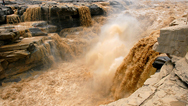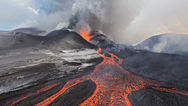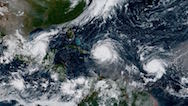What Makes a Hurricane?
- By Ana Aceves
- Posted 11.15.17
- NOVA
Hurricanes bring wind, rain, and destruction—but how do they form?
Transcript
What Makes a Hurricane?
Published November 15, 2017
Onscreen: Hurricanes
Massive whirling storms in the Atlantic and N.E. Pacific
With wind speeds over 74 mph
Bringing torrential rain, thunder and lightning.
The strongest hurricanes exceed wind speeds of 157 mph and can demolish nearly everything in their path.
What makes a hurricane?
1. Warm water needs to extend at least 200 feet into the ocean.
Kerry Emanuel: The hurricanes churn up cold water from beneath the warm water on the surface, so they cool the surface, it’s like throwing cold water on a fire.
Onscreen: 2. The cross winds near the top of the hurricane—called wind shear—can’t be too strong.
Kerry: That tends to blow dry air into the core of a hurricane that also is like throwing cold water on the fire.
Onscreen: 3. Hurricanes need moisture throughout the atmosphere. Then wind speeds rise within the eye of the hurricane.
Many factors can affect hurricane formation…including the climate.
A warmer climate will bring increased intensity of tropical storms.
Storms may not be more frequent…But the storms that do occur will tend to be more intense.
Credits
PRODUCTION CREDITS
- Digital Producer
- Ana Aceves
- KILLER HURRICANES
- Series Producer and Director
- Oliver Twinch
- Filming and Directing
- Paul Williams
- Editor
- Ben Lavington Martin
FOOTAGE AND GRAPHICS
- Visuals
- AP
Getty
NASA
Pond5
SFX
- Music
- APM
Related Links
-

Killer Hurricanes
Experts reconstruct the Great Hurricane of 1780 to help predict the risk of future storms.
-

Killer Floods
Discover how colossal floods transformed the ancient landscape.
-

Killer Volcanoes
Scientists hunt for a mega-eruption that plunged medieval Earth into a deep freeze.
-

2017 Hurricane Season Explained
After a quiet start, August and September quickly became filled with violent storms. What drove the change?

